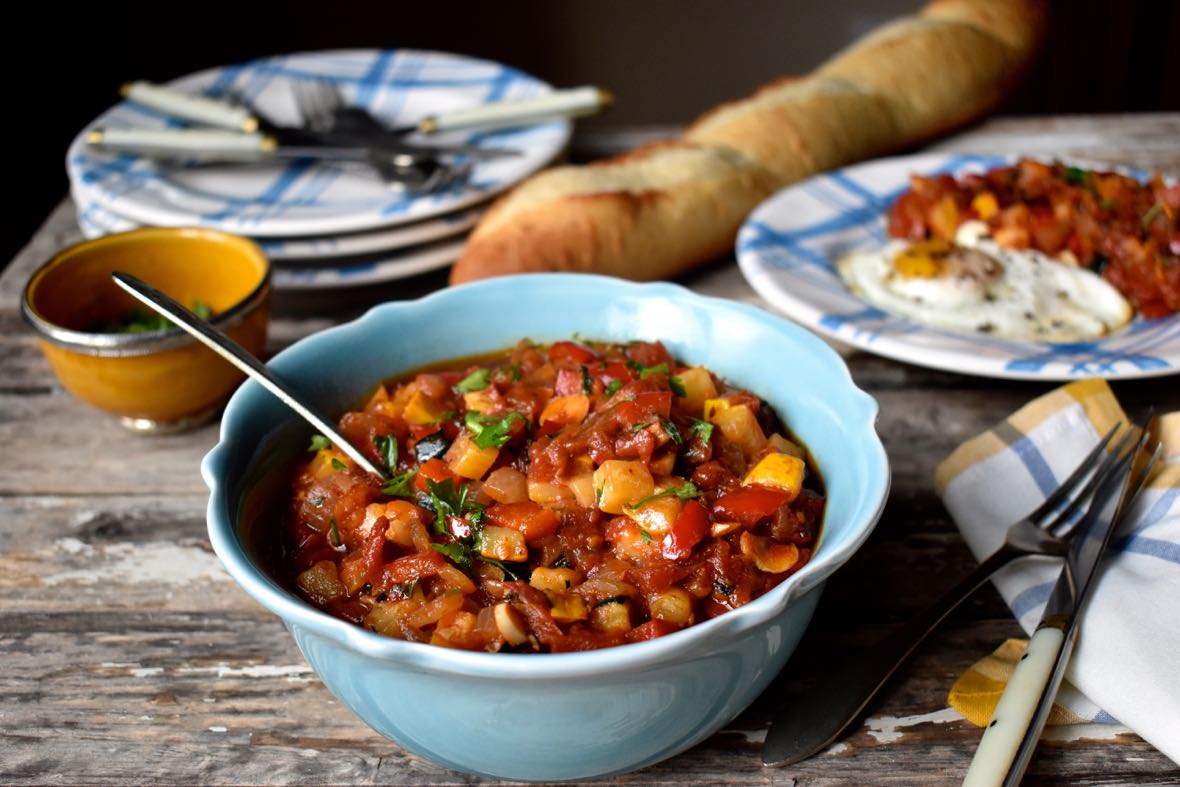Pisto —and building a vegetable garden (Part 3): THE FENCE
 I used so many of my garden vegetables for pisto that its recipe could only be posted alongside more on the progress of the vegetable garden, or Part 3.
I used so many of my garden vegetables for pisto that its recipe could only be posted alongside more on the progress of the vegetable garden, or Part 3.


Planting the seedlings on a very hot summer day
Tomatoes, peppers and zucchini have been growing with abandon, to the point where, mid November, I still have tomatoes ripening indoors. I’ve made tomato preserves to last us through the winter (check here to know how to make them), salads that took on many forms and ingredients, cakes (click here for the most moist, delicious zucchini cake), and even summer soups like cucumber gazpacho (click here).
Pisto is not only a recipe that includes many of the vegetables I grew (or did I grow the vegetables that I knew I was going to use in pisto and in gazpacho?), but also a recipe that is very versatile and keeps well for a few days in the fridge. It even freezes wonderfully. Serve it alongside eggs, chcken and other meats, or fish: it works well with almost any protein.

Where we left it on Part 2: beds set in the ground and fence posts erected

The fresh, rich, nutritious soil is ready to receive the seedlings

The seedlings have been growing indoors

The spray paint gun is very helpful, even if there’s a bit more paint waste

The trellises get to be painted too



Top and bottom rails have to be perfectly parallel

Everybody can lend a hand

Pisto is very popular in Spain, and the original recipe comes from the central region of the country, called La Mancha. This region gives its name to the dish: pisto manchego. However, there are slight variations of the dish in different parts of the country, so I will just call it pisto here. In my home region of Valencia, pisto also includes eggplant. You will not see it in the photos that accompany this post, because I didn’t have one! But most certainly, had I had one (I didn’t grow eggplants this year), I would have included it in the dish. I also like to add a little touch of lemon to my pisto, which is not part of the traditional recipe, so you can omit it if you want. I just think it adds a little extra freshness.

Until the fence is built, chicken wire will protect the young plants

Brothers teaming up





Rails almost set! We still have to wait for more wood at the lumber store

A lattice fence requires perfect measurements

At day’s end, time for recreation


Those smiles compete with the beauty of the burning sky

Stunning sunset
Part 2 of the vegetable garden involved painting the beds, setting the posts for the fence and setting the beds on the ground. In Part 3, building the fence took center stage, as well as planting the seedlings that I had been growing from seeds indoors. I had a much more active role at this stage, painting the wood that Dave and Ethan would later use for the fence. Once I finished painting the wood we had been able to find (remember, this project was done during confinement, and wood was in very short supply, as so many people decided to tackle different home projects), I planted the seedlings. It was wonderful to see them grow, and each day brought in new leaves, thicker stems, and eventually, tiny flowers that were the promise of a bountiful harvest.
More in Part 4!













PISTO
Equipment
Ingredients
- 1 medium zucchini or yellow squash
- 1 large onion
- 1 red pepper
- 1 orange or yellow pepper
- 1 medium eggplant optional
- 4 tomatoes
- 5 cloves garlic
- 1/2 cup extra virgin olive oil
- 1/2 tsp finely grated lemon zest
- 1 tsp lemon juice
- 2 or 3 branches of parsley
- Salt and pepper to taste
Instructions
- Dice the zucchini, onion and peppers into about 1/3 inch pieces. Peel the eggplant if using and dice into similar size pieces. Mince the garlic cloves. Finely chop the tomatoes.
- In a large cast iron casserole or dutch oven, heat 1/4 cup of olive oil. Add the eggplant if using and cook over medium to high heat, about 5 minutes. Season with salt and pepper and cook for an extra minute. Remove and reserve.
- Add 2 Tbs olive oil to the casserole and add the zucchini or yellow squash. Cook for about 5 minutes, season with salt and pepper and cook for an extra minute. Remove the squash and add it to the eggplant.
- Add 2 Tbs olive oil to the casserole and cook the onion and peppers. Cook for about 5 minutes, season with salt and pepper and cook for an extra minute. Remove the onion and peppers and add them to the eggplant and zucchini.
- Add the minced garlic to the casserole and cook for about 1 minute, making sure it doesn’t burn. Inmediately add in the tomatoes and cook for about 10 minutes. Add the vegetables and cook until the tomatoes are broken down, about 10 minutes. Add the minced parsley, lemon zest and lemon juice and cook for one extra minute.
Notes



























